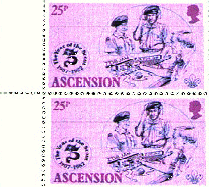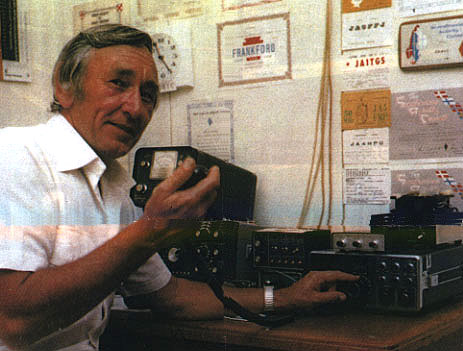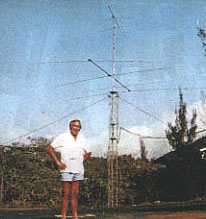by Ted, G4UPS (ZD8TC)
 Click here
to see Ted's QSL
Click here
to see Ted's QSL Click here
to see Ted's QSL
Click here
to see Ted's QSL![]() Ted, ZD8TC, (G4UPS) as heard in
Japan on SSB in 1983
Ted, ZD8TC, (G4UPS) as heard in
Japan on SSB in 1983
![]() Ted, ZD8TC, (G4UPS) causing a
pileup on CW!
Ted, ZD8TC, (G4UPS) causing a
pileup on CW!
 Ted, ZD8TC on a
stamp
Ted, ZD8TC on a
stampAscension Island lies in the South Atlantic at 7.55' south, 14.15' west. The island is quite small, approximately 34 square miles in area. In 1979 there was 35 miles in total of t& roads. Two Boats village is at the foot of Green Mountain and is the British base area. There are 44 major craters on this small island ! The island was discovered by the Portuguese navigator Joao da Nova Castella on Ascension Day 1501, but the island was not settled until the Royal Navy occupied it and built the first Permanent settlement in 1815. It was only occupied then to prevent the French from mounting a rescue mission to release Napoleon Bonaparte from his exile on St Helena, 700 miles (1000 kms) to the south. Ascension became H.M.S. Ascension - listed as a sloop of war, and until 1922 remained a British naval outpost and victualling station garrisoned by the Royal Marines. The small port settlement was first named Garrison, but was later renamed Georgetown after King George III. The Royal Marines left the island in 1922 when Ascension became a dependency of the British Crown Colony of St Helena. The island's administration was then delegated to the Eastern Telegraph Company now Cable & Wireless. In 1964 the administration of the island was delegated to an Administrator appointed by the Governor of St Helena.
Wideawake Airfield was built during World War II - in 1942 by US Army engineers. St Helena still has no airstrip. Needless to say, Ascension Island has an extremely interesting history. One of it's most famous visitors was William Dampier - the 17th century explorer, buccaneer and Admiralty hydrographer who's ship the Roebuck was wrecked on the island in 1701. Dampier found the only water source on the island - a small spring - now called Dampier's Drip on Green Mountain. It was Dampier who wrote the original story concerning Alexander Selkirk, the original Robinson Crusoe - but it was Daniel Defoe who's vivid narrative was revealed in the first volume of - " The Life and Strange Suprising Adventure of Crusoe", published in 1719. Selkirk had been marooned on Juan Fernandez Island from 1704 until he was rescued on the 31st January 1709. I am very fortunate in having a copy of the research material on Dampier and Selkirk, written by Robin Hanney who worked on Ascension Island and who died in the early 1980s on the island and is in fact buried in the small island cemetery near Georgetown.
I also have a copy of the history of Wideawake Airfield by Jeffery Alan Cant printed in 1973. If there is anyone out there that is interested in the fascinating history of Ascension Island I would be only too pleased to photocopy all the private material I have.
 The
Arrival of ZD8TC
The
Arrival of ZD8TC I arrived on Ascension Island in January 1979, with my wife, for a three year tour as a Radio Officer with Government Communications. I had started in amateur radio initially when I was in charge of the Royal Signals unit with the Rifle Brigade in Minden in 1949. I was issued with the callsign DL2PP by the Control Commission. That callsign was re-issued to a German amateur many years later I started operating as ZD8TC in August 1979. I had purchased an old FT101B from Tommy ZD8TM who also gave me a Junker hand key to start me off on the amateur bands as ZD8TC. I initially used wire antennas until I could make a few Yagis out of scrap metal found on the local rubbish dump. I lived in Two Boats village at the foot of Green Mountain. I was fortunate in starting as we neared the solar cycle. Very little was required in the form of antennas or power - the call sign prefix ZD8 was worth a kilowatt of power in any situation. I eventually ended up entering most of the major contests of the time, especially the RSGB contests. Within a short space of time the extreme generosity of our American friends provided me with a QSL manager, Gary N2CW, and the South Jersey DX association very kindly provided me with QSL cards. At the time the only regular flights to Ascension Island were from the US - military flights - so the only regular route for ham radio help was via W land. After about 6 months of regular hamming on the HF/LF bands - PY1RO, Rolf Rasp, started asking me if I could help to trace a 6m rig which had been sent to Ascension, to the US base, in the hope that someone would put ZD8 on the 6m band. I eventually traced the rig - a Gonsett Sidewinder - still packed in the box in which it had been dispatched from the US. It was handed over to me to see if it was working. The first difficulty to overcome was the fact that the voltage required was US standard! Two Boats village and all the British working areas were UK standard - the US base was US standard voltage. However, with a lot of help from the US base I eventually was able to test the Gonsett with a home brew metal horizontal dipole. At the time, because I was extremely busy on all bands, especially at weekends during contests, I regarded the 6m experiments as a real intrusion of my limited time.
 Ted's Original 6m
Permit Extension
Ted's Original 6m
Permit Extension
Before I actually tested the Gonsett I had applied to the Governor of St Helena for permission to operate on the 6m band, dated 5 May 1980. This was the first 6m permit ever issued according to the authorities on St Helena. Note that St Helena even to this day, has no landing strip, so communications were limited to radio or to the regular mail boat, the RMS St Helena. When applications were made they were submitted via the Administrator of Ascension Island, who normally first contacted the authorities on St Helena by phone, and for most normal applications verbal permission was given at the time of submission, because written permission very often could take several months to arrive via ship! However, I was assured that I was the first radio amateur on Ascension Island to have formal permission to operate on the 6m band. One of my first QSOs on 6m was with Rolf, PY1RO. The Gonsett was putting out about 8 watts into the horizontal dipole at the time.
 Ted, ZD8TC, standing next to his tower
Ted, ZD8TC, standing next to his tower
There were very few beacons on the 6m band in those days. The most frequently heard ones were, PY2AA, ZB2VHF, FY7THF, 5B4CY and for a time during the peak of the solar cycle, Piero I5TDJ was issued with a special permit to run a beacon on 50.315 MHz and to make QSOs on that one frequency. DL3ZM/YV5, 5Z4YV, EL2FY, EL2AV, SZ2DH (SV1DH) VS6BE, F08DO and many other were regularly worked from ZD8 on 6m. Almost all the VS6/JA/KH6 QSOs took place after 2200 UTC! Quite often the pile-ups would continue past 0100 UTC. ZD8 time is GMT throughout the year so I did end up feeling rather tired many times - getting up for my day work. There were daytime openings, but very few of them. Very few European countries allowed 6m operations in those days, but there were a hard core of very dedicated people who kept 28.885MHz very busy working cross-band to 6m. Initially I experimented with various types of dipoles and ground plane antennas until later when Yagis arrived on the island. Even after I had the 4-ele Yagi up and running, I still kept a dipole and a GP antenna for use for searching around the band and also for portable use from the top of Green Mountain. I built a simple bridge which automatically selected the best antenna at any moment ( which selected the antenna that produced the best incoming signal) so that I could compare the variations in polarity changes over the longer hauls. The GP antenna proved excellent for portable use from Green Mountain. It was built of copper piping and proved very successful for working across to LU, PY, CX, CP and many other South American countries. However, all these experiments were conducted under peak solar cycle conditions, when even wet string produced results. It did not take long to have logged many hundreds of JA stations on 6m - well over 700 when Bak JA1BK arranged the dispatch of a brand new Kenwood TS600 a dedicated 6m rig, with all accessories and a small amplifier to make operating on 6m a pleasure after using the rather battered Gonsett with it's rather chirpy note. These items were provided as a gift, and I arranged for photographs to be taken showing me using the new rig. See the colour picture of me using the TS600 - a picture which was also used for advertising Kenwood. All the equipment which was sent to the island came via the US, and many kind amateurs gave help in routing the items through the US to the American airbase in Florida for loading to ZD8. I have never forgotten the kindness and generosity of so many people around the world that made life on such an isolated island so much more bearable, and I hope I helped to repay some of the kindness by operating on the amateur bands to give ZD8 to as many operators as possible. After I had received the new TS600 I packed up the Gonsett Sidewinder and sent it on the R.M.S. St Helena down to ZD7 for the use of ZD7BW who was keen to get on the 6m band. I was lucky enough to be his first 6m QSO - and he was my nearest 6m neighbour - only 700 miles away.
I was rather fortunate that for all of my tour of Ascension Island I was on day work, consequently I was usually around for the evening openings on 6m. However, I did leave the 6m rig running on 50.110 MHz whilst at work, when my XYL was around to alert me to any noise heard on the calling frequency. I was actually having my lunch on the 30 April 1981 when I did hear a weak noise on 50.110 MHz ... I almost fell off the chair when I heard the callsign H44PT I worked Peter H44PT, my exact antipode whose grid locator was RI00AM - we exchanged 53 SSB both ways for what was then a world record for distance on the 6m band - 17,985 kms - still a distance record from ZD8.
One characteristic of the JA openings was the fact that almost all of them were proceeded by JA6 stations being worked, they would fade out before the JA stations became audible. Most of these opening would continue until the early hours of the morning.
I was very fortunate that at the peak of the Solar cycle, many of the DX expeditions like KP1, CEO etc. operated on the 6m band. In total I worked 76 countries on 6m - when I left Ascension Island in 1982 that was the world record. I also worked 14 different countries crossband. Remarkably the 76 countries still stands as a record for 6m from ZD8 despite the many new countries that are now active on 6m. Eventually I ended up purchasing a tower with an HF Yagi, with the 6m Yagi above and with a rotator . Oh I how much easier life on the bands became from then on.
 Ted,
G4UPS's Original 1984 UK 6m Permit
Ted,
G4UPS's Original 1984 UK 6m Permit
When I arrived back in the UK, I had to resit for my G licence in 1983 and as soon as I had my G4UPS callsign I immediately applied for a 6m permit. Photocopy of the permit is attached - maybe some people might like to see what the original permits for 6m were like. Times of operations on 6m were very limited - in fact to the hours when there were no TV transmissions - early morning and late evening ! But despite the time restrictions we were still able to QSO across the pond.
![]() Click here to go back to the
DXpedition page
Click here to go back to the
DXpedition page